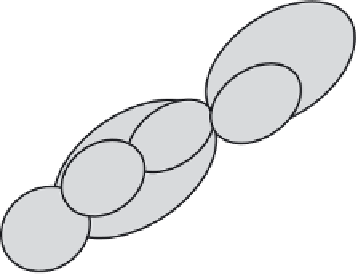Environmental Engineering Reference
In-Depth Information
10
5
A
10
4
10
3
10
2
10
1
10
0
10
-1
10
-2
10
-3
10
-4
10
-2
10
-1
10
0
10
1
10
2
10
3
10
4
10
5
10
6
10
5
B
10
4
Ecosystem engineers
(beavers, alligators,
hippopotamus)
10
3
10
2
10
1
10
0
10
-1
Detritus
(coarse and fine
organic material)
10
-2
10
-3
10
-4
10
-2
10
-1
10
0
10
1
10
2
10
3
10
4
10
5
10
6
Temporal scale of change (y)
FIGURE 5.19
Hierarchical representation of the geomorphological changes in stream chan-
nels (A) and related biotic processes (B) (after Alan, 1995; Frissell
et al.,
1986; Mitsch and
Gosselink, 1993).
SUMMARY
1. Permanent rivers are more common where precipitation is greater;
intermittent rivers are characteristic of regions of low or sporadic
precipitation.
2. Rivers can be classified by watershed area, stream order, variations in
discharge over time, and vegetation.
3. Stream habitats can be characterized into riffles, pools, runs, and falls.
These habitats are mostly scale independent.
4. Streams naturally meander; the water flow patterns alter erosion and
deposition in such a way that meanders increase in size until they
eventually close off and form oxbow lakes. This meandering is scale
independent and occurs in rivers and streams regardless of size.
5. Humans have drastically altered the morphology of stream and river
channels throughout the world with activities such as channelization,


























































































Search WWH ::

Custom Search